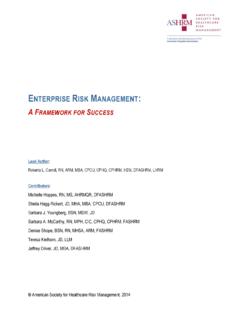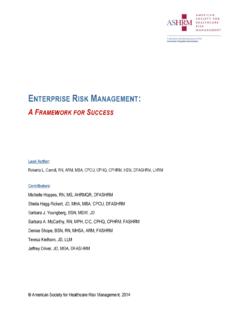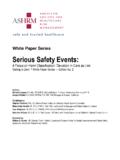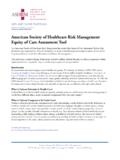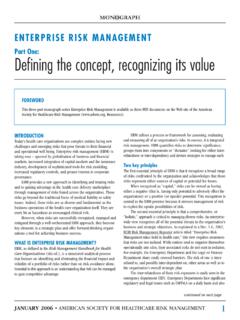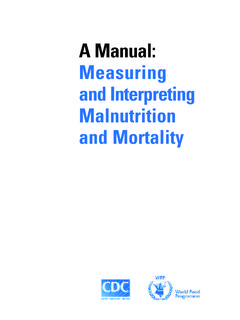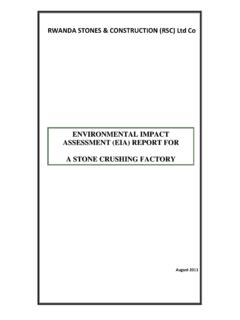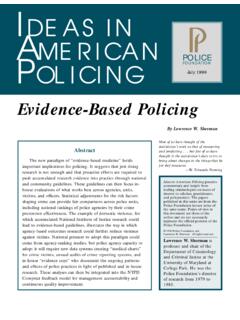Transcription of ENTERPRISE RISK MANAGEMENT: Implementing ERM
1 ENTERPRISE RISK MANAGEMENT: Implementing ERME ditors:Sheila Hagg-Rickert, JD, MHA, MBA, CPCU, DFASHRMAnn Gaffey, RN, MSN, CPHRM, DFASHRMC ontributors: Roberta L. Carroll, RN, ARM, MBA, CPCU, CPHQ, CPHRM, HEM, LHRM, DFASHRM Franchesca J Charney, RN, MS, CPSO, CPPS, CPHRM, DFASHRM Jeffrey Driver, JD, MBA, DFASHRM Michelle Hoppes, RN, MS, AHRMQR, DFASHRM Teresa Kielhorn, JD, LLM Barbara A. McCarthy, RN, MPH, CIC, CPHQ, CPHRM, FASHRM, DFASHRM Denise Shope, BSN, RN, MHSA, ARM, FASHRM, DFASHRM Barbara J. Youngberg, BSN, MSW, JD2 American Society for Health Care Risk Management 2020 ASHRMThe American Society for Health Care Risk Management (ASHRM)of the American Hospital Association155 North Wacker Drive, Suite 400 Chicago, IL 60606(312) view additional ASHRM white papers, visit provides this document as a service to its members.
2 The information provided may not apply to a reader s specific situation and is not a substitute for the application of the reader s independent judgment or the advice of a competent professional. Neither ASHRM nor any author makes any guarantee or warranty as to the accuracy or completeness of any information contained in this document. ASHRM and the authors disclaim liability for personal injury, property damage or other damages of any kind, whether special, indirect, consequential or compensatory, that may result directly or indirectly from use of or reliance on this OF CONTENTS INTRODUCTION ..4 FRAMEWORK ..4 GUIDING PRINCIPLES ..5 GOVERNANCE AND CULTURE ..5 ERM PROCESS ..9 RISK & OPPORTUNITY IDENTIFICATION ..9 KPI S, PERFORMANCE MEASUREMENT, KRI S AND TOLERANCE ..10 RISK EVALUATION & assessment .
3 12 STRATEGIC RISK RESPONSE ..17 REVIEW/EVALUATE/MONTIOR ..19 INFORMATION AND COMMUNICATION ..20 CONCLUSION ..20 REFERENCES .. 214 American Society for Health Care Risk ManagementINTRODUCTIONThe advancement of Health Care ENTERPRISE Risk Management is a key initiative in ASHRM s Strategic Plan for 2019-2021. The implementation and maturity of ERM programs in health care organizations while making significant strides still lag behind organizations in other industries; most financial services organizations and most public companies. Although many health care risk-management professionals implement ERM strategies for new programs, projects and services (particularly to manage clinical, and patient-safety related risks), they fail to advance ERM strategies on an organization-wide basis beyond those risks and thus miss tremendous opportunity to increase or create value.
4 Recognizing the elements necessary for ERM program development and implementation and embedding them in the ENTERPRISE is central to program success and this key ASHRM initiative is the adoption of a framework around which an ERM Program can be structured along with a clear, concise and easily understood definition of ERM. This paper offers guidance on ERM methods specific to health care organizations. It outlines the COSO framework, which ASHRM aligns with, and highlights structural components to support a solid foundation, promote program credibility and success, and advance ERM principles throughout your health care Framework, as illustrated in this paper (See Figure 1) COSO ERM Framework, depicts a sample structure that can be utilized by any risk management professional as the developmental foundation of an organization-wide ERM program.
5 Understandably, each organization s ERM program will vary due to differences in mission, vision, culture and strategic direction. However, components and principles shown in the sample Framework are relevant to any health care organization. Each group may adopt these elements in a manner that accommodates the differences noted. Flexibility is important as a one-size-fits-all approach is not applicable in ERM. Realizing this at the outset will encourage risk management professionals to define and modify basic structural elements in the Framework to fit their specific organizational needs, particularly as they relate to unique delivery settings. This sample Framework allows for vital flexibility to create a unique and individualized health care ERM program. Once a Framework to address the specific needs of the organization is developed, creating program success building blocks can be developed and implemented following : Health care organizations have made significant strides in developing ENTERPRISE Risk Management (ERM) programs, but there is still much work to be done.
6 To facilitate this process, ASHRM has adopted an ERM definition and an ERM Framework for use in health care. This framework is based on that developed by the Committee of Sponsoring Organizations of the Treadway Commission (COSO) in 2017. This white paper will graphically display the Framework and describe key structural components necessary in any health care setting. Use this Framework to help build consistency in your efforts to move ERM forward. Audience: Novice, intermediate risk professional, or anyone desiring more information on ERMK eywords: ENTERPRISE Risk Management, ERM, Framework, Guiding Principles, Governance, Risk & Opportunity Identification, assessment , Risk Response, Risk 1: COSO ERM Framework A Focused FrameworkENHANCEDVALUEMISSION,VISION,&CO RE VALUESBUSINESSOBJECTIVEFORMULATIONSTRATE GYDEVELOPMENTONREEBUSOBJFORMSIEMUNESSECT IVEULATIOAANIMPLEMENTATION& PERFORMANCEN,VISION,VAVVLUESSTRDEVERLNTR ATEGAAYLOPMENENHANCEVAVVLUEENTATIOAANNOR MANCEEENENTERPRISE RISK MANAGEMENTR eview & RevisionInformation, Communication, & ReportingPerformanceStrategy & Objective-SettingGovernance & CultureEnterprise Risk Management Integrating with Strategy and Performance clarifies the importance of ENTERPRISE risk management in strategic planning and embedding it throughout an organization because risk influences and aligns strategy and performance across all departments and PRINCIPLESR eview & RevisionInformation, Communication.
7 & ReportingPerformanceStrategy & Objective-SettingGovernance & Culture1. Exercises Board Risk Oversight2. Establishes Operating Structures 3. Defines Desired Culture 4. Demonstrates Commitment to Core Values5. Attracts, Develops, and Retains Capable Individuals6. Analyzes Business Context7. Defines RiskAppetite8. EvaluatesAlternative Strategies9. Formulates Business Objectives10. Identifies Risk 11. Assesses Severity of Risk12. Prioritizes Risks13. Implements Risk Responses14. Develops Portfolio View15. Assesses Substantial Change16. Reviews Risk and Performance17. Pursues Improvement in ENTERPRISE Risk Management18. Leverages Information andTechnology19.
8 Communicates Risk Information20. Reports on Risk, Culture, and PerformanceSource: 2017, Committee of Sponsoring Organizations of the Treadway Commission (COSO). All rights reserved. Used with permission. GOVERNANCE AND CULTUREThe Governing Body of each health care organization is ultimately responsible for its ERM program. It is accountable either directly or through the leadership team for: Defining ERM as appropriate for the organization Creating and maintaining a culture that is supportive of ERM Determining strategy and program objectives Establishing parameters and levels of risk appetite and assessing risk capacity Establishing ERM operating and reporting structure Approving the ERM plan, including plans for ERM education and communication Providing ERM program oversightEach of these areas is described in more detail below.
9 Definition of ERMA dopting a definition of ERM that is clear, concise and understandable is one of the significant early steps in developing an ERM Program. Without an articulated definition the organization can embrace, the activities associated with ERM development and implementation can become disjointed and without purpose. ASHRM has adopted the following definition. ENTERPRISE risk management in health care promotes a comprehensive framework for making risk management decisions which maximize value protection and creation by managing risk and uncertainty and their connections to total value. Developed by ASHRM s ERM Advisory Committee and adopted by the ASHRM Board on September 19, 20126 American Society for Health Care Risk ManagementOther credible organizations such as the Committee of Sponsoring Organizations of the Treadway Commission (COSO), The American Heath Lawyers Association (AHLA), the Risk and Insurance Management Society (RIMS), and the International Organization of Standardization ISO 31000:2009 have all defined ERM, albeit differently.
10 See the Endnotes for those definitions. See Figure 2 for terms and complimentary FrameworkValue ProtectionValue CreationManaging Uncertainty Organizational-wide Holistic Broad perspective Synergistic effect Comprehensive Strategic Thorough Robust Structured Reduce uncertainty Reduce variability Duplication Separation Shield asset Efficient use of resources Quality outcomes Safe practices Increased market share Competitive edge Financial strength Improved ROI Increased margins Enhanced reputation Improved satisfaction scores Quality Outcomes Credible Respected Reduce Risks Eliminate Loss Promote standardization Use Evidence-Based Practice Decrease Variability View the impact of risk holistically not in silos
